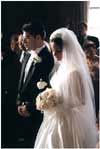 Horoscope Matching(sample)
Horoscope Matching(sample) |
 Melapak Report
Melapak Report |
 Astrology Services
Astrology Services |
 Astrology Books
Astrology Books |
 Aryabhatt Shopping
Aryabhatt Shopping |
 Shaadi Muhurats
Shaadi Muhurats |

|
|
|
|
|
|
|
THE MARRIAGE CEREMONY OF THE JEWS
Introduction
In Jewish tradition, marriage is considered sanctification.
The word for marriage, "kiddushin", is derived from the root word, "kadosh", which means
holiness. The favourite day for Jewish marriage is a Tuesday.
Pre Wedding Ceremony
On the wedding day, the bride and groom observe fast. If the
wedding is in the afternoon, the bride and the groom recite "Yom Kippur Viddui
"(confessional) prayers privately before the wedding ceremony in order to forget
their past and live a married life with purity and forgiveness. Before the
wedding ceremony a ritual called "Badeken" is performed which gives an
opportunity to the bride as well as the groom to see one another accompanied by
the relatives of either party.
 Wedding Ceremony Wedding Ceremony
The
Rabbi first checks under the "huppah" (canopy under which the religious ceremony
is performed) to make sure there are two "Kiddush" cups and wine that will be
used during the ceremony. The bridesmaids, usherers, maid and matron of honour,
best man and other relatives surround the "huppah". The bride and groom walk
down the aisle separately, each accompanied to the "huppah" by his/her parents.
The groom's party enters first, and the last to enter are the bride and her
parents. Then the couple stands side by side, under the "huppah". The "huppah"
symbolizes the new home of the bride and groom. The rabbi recites the blessings
over a cup of wine, from which the bride and groom take a sip each. The wedding
begins by exchange of rings and recitation of the marriage formula.  The Rabbi then reads
the "Ketubah" (This is the marriage contract, which is written beforehand,
signed by two witnesses and which stipulates the dowry as well as the amount the
wife will receive should her husband divorce her). Then he hands over the
"ketubah" to the groom, who in turn gives it to the bride to keep. This
completes the legal part of the ceremony. To close the ceremony seven additional
blessings of marriage, known as "Sheva (seven) B' Rachot", are recited over cup
of wine. Thus the wedding ceremony is over after all the relatives bless the
couple over a cup of wine and then an empty glass wrapped in cloth is placed
under the groom's foot. He stomps on it vigorously, shattering it. It is a
symbolic act designed to recall the destruction of the Temple in Jerusalem. The
bridegroom then kisses the bride. The Rabbi then reads
the "Ketubah" (This is the marriage contract, which is written beforehand,
signed by two witnesses and which stipulates the dowry as well as the amount the
wife will receive should her husband divorce her). Then he hands over the
"ketubah" to the groom, who in turn gives it to the bride to keep. This
completes the legal part of the ceremony. To close the ceremony seven additional
blessings of marriage, known as "Sheva (seven) B' Rachot", are recited over cup
of wine. Thus the wedding ceremony is over after all the relatives bless the
couple over a cup of wine and then an empty glass wrapped in cloth is placed
under the groom's foot. He stomps on it vigorously, shattering it. It is a
symbolic act designed to recall the destruction of the Temple in Jerusalem. The
bridegroom then kisses the bride.
Post Wedding Ceremony
The couple along with the relatives and friends head for
reception. The wedding feast is known as "seudat mitzwah". During the reception,
the bride and the groom are seated in the center of the dancing circle, or
carried aloft in chairs, while their friends clap and sing around
them.
|
|


 Wedding Ceremony
Wedding Ceremony  The Rabbi then reads
the "Ketubah" (This is the marriage contract, which is written beforehand,
signed by two witnesses and which stipulates the dowry as well as the amount the
wife will receive should her husband divorce her). Then he hands over the
"ketubah" to the groom, who in turn gives it to the bride to keep. This
completes the legal part of the ceremony. To close the ceremony seven additional
blessings of marriage, known as "Sheva (seven) B' Rachot", are recited over cup
of wine. Thus the wedding ceremony is over after all the relatives bless the
couple over a cup of wine and then an empty glass wrapped in cloth is placed
under the groom's foot. He stomps on it vigorously, shattering it. It is a
symbolic act designed to recall the destruction of the Temple in Jerusalem. The
bridegroom then kisses the bride.
The Rabbi then reads
the "Ketubah" (This is the marriage contract, which is written beforehand,
signed by two witnesses and which stipulates the dowry as well as the amount the
wife will receive should her husband divorce her). Then he hands over the
"ketubah" to the groom, who in turn gives it to the bride to keep. This
completes the legal part of the ceremony. To close the ceremony seven additional
blessings of marriage, known as "Sheva (seven) B' Rachot", are recited over cup
of wine. Thus the wedding ceremony is over after all the relatives bless the
couple over a cup of wine and then an empty glass wrapped in cloth is placed
under the groom's foot. He stomps on it vigorously, shattering it. It is a
symbolic act designed to recall the destruction of the Temple in Jerusalem. The
bridegroom then kisses the bride.